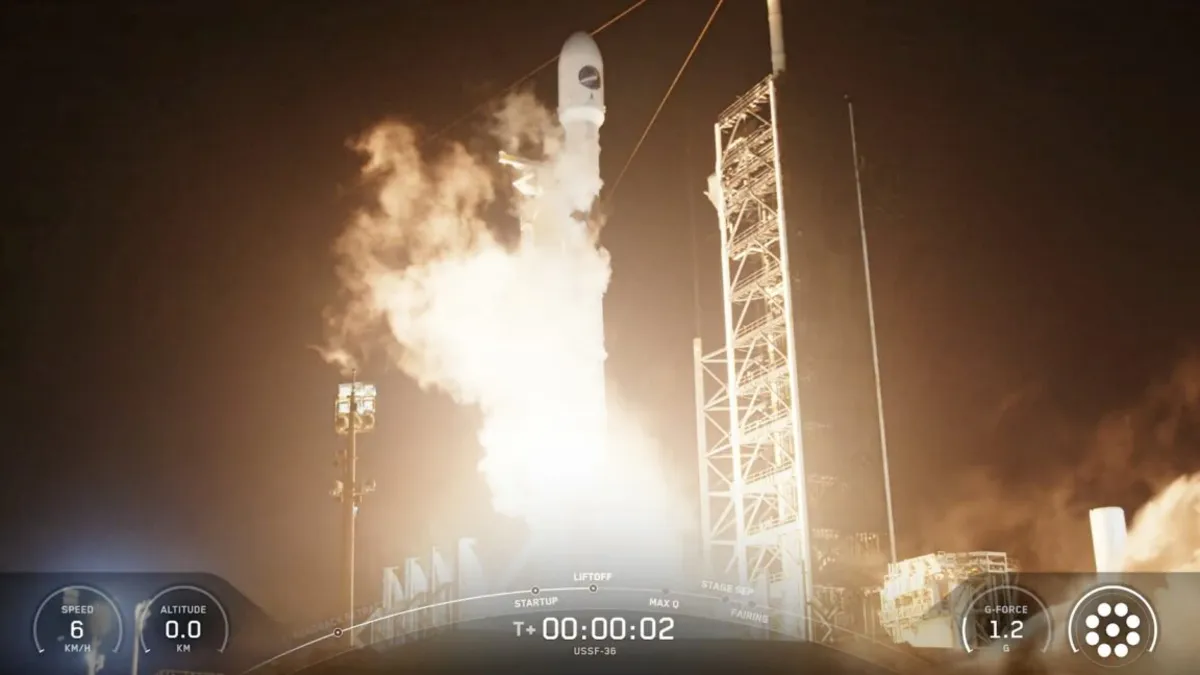
The US military's reusable winged spaceship, known as the X-37B spaceplane, successfully launched into orbit on Thursday night atop a SpaceX Falcon 9 rocket. This mission aims to showcase advanced navigation capabilities that do not depend on traditional GPS signals. At the core of this navigation experiment is a revolutionary quantum inertial sensor, touted by the Space Force as the world's highest performing of its kind utilized in space.
The X-37B lifted off from the Kennedy Space Center in Florida at 11:50 PM EDT Thursday (03:50 UTC Friday). The Falcon 9 rocket navigated downrange, heading northeast along Florida's Space Coast. After its first stage booster detached, it successfully landed at the nearby Cape Canaveral Space Force Station. Meanwhile, the upper stage of the Falcon 9 propelled the X-37B into a low-Earth orbit. Space Force officials confirmed the launch's success in an early Friday press release.
This mission marks the eighth flight of the X-37B spaceplane since its debut in April 2010. The X-37B program consists of two Boeing-built spaceplanes, which resemble smaller, uncrewed solar-powered versions of NASA's retired space shuttle orbiters. The program is managed by the Air Force Rapid Capabilities Office in collaboration with the Space Force.
The X-37B serves as a technological testbed designed to transport various experiments between Earth and space. While many payloads aboard the spaceplane are classified, officials typically disclose a few unclassified experiments for each mission. Past X-37B missions have included the deployment of small satellites before safely landing back on Earth at either Kennedy Space Center or Vandenberg Space Force Base in California.
On this mission, the Space Force has revealed that the X-37B is equipped with instrumentation intended to demonstrate quantum navigation capabilities, alongside a laser inter-satellite relay terminal. This terminal will facilitate communication with other spacecraft in orbit. The quantum sensor package will enable precise navigation in space by measuring the rotation and acceleration of atoms, eliminating the need for traditional GPS satellite networks, according to a statement from the Space Force prior to launch.
The Space Force operates the Global Positioning System (GPS) satellite network to provide crucial navigation services for various vehicles, including ships and airplanes. Initially designed for military use, GPS has become a vital tool in civilian life, from commercial aviation to everyday navigation. However, the reliance on GPS signals makes them vulnerable to jamming and spoofing, particularly in conflict zones like Ukraine and the Middle East.
In light of these vulnerabilities, the Space Force's quantum sensor experiment aboard the X-37B aims to explore navigation methods that can function in environments devoid of GPS signals. This quantum navigation technology could prove invaluable for deep-space missions, including those to the Moon or other planets, where GPS reception is not feasible.
The quantum experiment on the X-37B is the result of a collaborative initiative led by the Defense Innovation Unit (DIU) and the Office of the Undersecretary of Defense for Research and Engineering. Two companies, Vector Atomic and Honeywell Aerospace, have partnered to develop an atomic gyroscope that has undergone qualification for spaceflight. This gyroscope is capable of detecting motion with enhanced precision compared to traditional gyros used in drones, planes, and satellites.
The quantum payload aboard the X-37B integrates this atomic gyroscope into an inertial measurement unit. This device is essential for spacecraft to track their movement through three-dimensional space, determining their speed and direction. This experiment is part of the DIU's Transition of Quantum Sensing program, which aims to test quantum sensors across all military domains: land, sea, air, and space.
The Pentagon's twin X-37B spaceplanes have spent over 4,200 days in orbit, equivalent to approximately 11-and-a-half years. Most of this time has been spent in secrecy. The most recent flight, Mission 7, concluded in March with a runway landing at Vandenberg after a mission lasting more than 14 months, during which the spaceplane reached an altitude of nearly 25,000 miles (40,000 kilometers).
As the X-37B embarks on Mission 8, it returns to low-Earth orbit to conduct experiments focused on quantum navigation and laser communications. These missions demonstrate capabilities that were scarcely envisioned 15 years ago when the X-37B first launched. At that time, quantum sensing was still a nascent field, and laser communication technologies in space were just beginning to emerge.
The laser communications experiments on this mission will involve optical inter-satellite links with proliferated commercial satellite networks in low-Earth orbit, likely referencing SpaceX's Starlink or Starshield broadband satellites. Laser links promise to enhance data transmission speed while providing improved security against interception.
General Chance Saltzman, the chief of space operations for the Space Force, emphasized that the laser communications experiment represents a significant step in enhancing the US Space Force's ability to utilize proliferated space networks. This initiative aims to create a more resilient, reliable, and adaptable satellite communications architecture while improving data transport speeds.